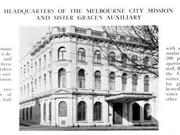
Headquarters of the Melbourne City Mission and Sister Grace's Auxiliary, c. 1949, courtesy of Melbourne City Mission, Melbourne: Specialty Press.
Details
The Melbourne City Mission was formed in the mid-1850s, as a result of the efforts of Hester Hornbrook, a philanthropist, and John Singleton, a medical doctor. Hornbrook and Singleton's vision was for 'a mission embracing all denominations and unsectarian in its character' to address the hardship and suffering caused by the social upheaval of the gold rushes. Melbourne City Mission ran a number of institutions for children and women. In 1970, the organisation changed its name to the Community Welfare Foundation. (In 1979, its name reverted back to Melbourne City Mission.)
Dr John Singleton was a prominent philanthropist and evangelist in Melbourne during the late nineteenth century. Dr Singleton was responsible for many institutions providing charitable relief, including night shelters, widows' cottages and female rescue homes. Along with Hester Hornbrook, Singleton founded the Melbourne City Mission in 1854. (Hester Hornbrook was president of Melbourne City Mission from 1856 until her death in 1862.)
Originally, the Melbourne City Mission was modelled on the London City Mission, but adapted its rules 'to the needs of the colony'. By the end of the nineteenth century, the Mission's work had broadened to include charitable or welfare work and the administration of residential institutions responding to the immediate needs of those in poverty or distress.
The Melbourne City Mission Maternity Home was established in 1900. In around 1935 a Toddlers' Home was established on the same site in Albion Street.
Melbourne City Mission also provided services to homeless men from its mission 'for the friendless and fallen' at 169 Exhibition Street, led by the work of Sister Grace. The Mission also had a Home for 'Friendless Girls', sometimes referred to as Sister Grace's Auxiliary (The Herald, 4 January 1923), a hostel for young women looking for work in the city.
In 1926, the Mission moved into new headquarters at 280 Exhibition Street, in a delicensed hotel. This new building included a hostel for 'friendless girls', 30 of them could be accommodated in dormitories on the third floor. The hostel was known by a number of names, including the Haven of Hope and Sister Grace's Home for Friendless Girls.
In addition to its headquarters, Melbourne City Mission had district centres in Brunswick, Collingwood, North Melbourne, Port Melbourne and Richmond. In the 1930s, it ran a holiday home in Black Rock for children whose parents attended the Mission halls, known as Happy Days,
In 1949, Melbourne City Mission described itself as 'an interdenominational institution registered with the Charities Board of Victoria operating amongst the poor, outside the Churches, supported by voluntary contributions'.
In addition to its institutions for children and mothers, the Mission ran Homes for Aged Women in Collingwood (in what was originally Dr Singleton's Home for Fallen and Friendless Women), and Pilgrim's Rest in Fairfield.
In 1943, Melbourne City Mission took over management from the Quakers of the Elizabeth Fry Retreat in South Yarra, an institution for 'wayward girls'. In 1957, it was renamed Swinborn Lodge.
In around 1955, the Maternity and Toddlers' Homes in Brunswick merged to form Hartnett House.
From the 1960s the Mission's approach changed to a focus on the structural and policy issues of social problems, with responses developed within a professional social welfare context.
In 1970, the Melbourne City Mission changed its name to the Community Welfare Foundation as a reflection of the agency's moves to 'professionalise' its services and to distinguish it from other agencies. However, the change of name was not a total success, causing confusion in the community and a sense of loss of continuity with the agency's historical roots. The name reverted to Melbourne City Mission in 1979.
Melbourne City Mission made a strategic decision to develop responses to youth homelessness in the 1990s.
The spelling of the organisation's name changed from Melbourne City Mission to Melbourne Citymission in the early 2000s.
Melbourne Citymission's website includes an 'Apology to the Forgotten Australians who were in Melbourne Citymission's care' from its Chief Executive Officer.
Melbourne Citymission apologises unreservedly for any harm, distress or hurt that may have occurred to children and young people while in the care of its institutions and other out-of-home care facilities.
The 'Forgotten Australians' Senate Inquiry has shown that life in institutional care was often bleak and caused lifelong pain and difficulties for many care leavers.
Melbourne Citymission deeply regrets any abuse, neglect and lack of appropriate care and nurture of children in its care. We accept that some children did not receive the love, nurturing and care to which they were so rightly entitled.
Melbourne Citymission encourages past care leavers who wish to discuss their experience with our services to make contact with us. We are committed to Support care leavers to tell their story, recover their history or find supports that may be needed.
1854 - 1970 Melbourne City Mission
1970 - 1979 Community Welfare Foundation
1979 - c. 2000 Melbourne City Mission
2000 - Melbourne Citymission
Sources used to compile this entry: Creatures that once were men, The Herald, 4 January 1923, 14 pp, http://nla.gov.au/nla.news-article246671320; The Melbourne City Mission, The Age, 29 May 1928, 5 pp, http://nla.gov.au/nla.news-article202301907; James Jenkinson Consulting, Guide to out-of-home care services 1940-2000 - Volume One: Agency Descriptions, Department of Human Services, Unpublished, November 2001, https://www.childabuseroyalcommission.gov.au/sites/default/files/DHS.3004.011.0367.pdf; Leeson, E., Melbourne City Mission 1855-1949, Melbourne City Mission, Melbourne: Specialty Press, Melbourne, 1949?, 31 pp. Also available at http://handle.slv.vic.gov.au/10381/130489; Morrissey, Sylvia, 'Singleton, John (1808-1891)', in Australian Dictionary of Biography Online Edition, 2006, http://adb.anu.edu.au/biography/singleton-john-4584.
Prepared by: Cate O'Neill
Created: 1 May 2009, Last modified: 18 December 2018